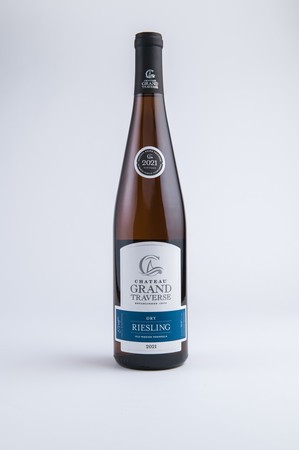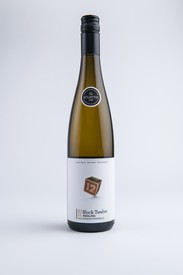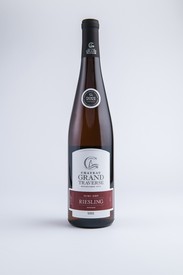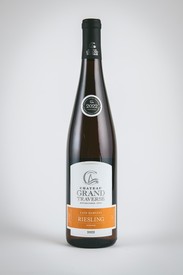DRY RIESLING
Our Dry Riesling channels the Old Mission Peninsula’s maritime influence and glacial soils into a linear, citrus-driven white. Cool nights retain the grape’s natural acidity, making this expression more structured and austere than its German Kabinett cousins.
Pale straw in hue with green reflections. Expect aromas of lime zest, white peach, and green apple, followed by hints of jasmine and wet stone. The palate is taut, dry, and mineral-driven, with a focused core of lemon-lime brightness, white flowers, and subtle herbal lift. Its long, saline finish captures the hallmark elegance that defines Old Mission Peninsula Riesling.
The 2023 vintage of our Dry Riesling reflects a season that tested patience yet rewarded precision. The growing year began with mild winter conditions and a warmer-than-average spring, allowing smooth vineyard preparation and an even, healthy bloom. Summer’s drought-like stretch into early September slowed ripening, concentrating flavors in the grapes. Then, timely seasonal rains refreshed the vines, restoring balance without diluting character. While harvest brought above-average rainfall, it arrived in short, infrequent bursts—allowing fruit to be picked in prime condition.
With 2,302°F degree days and slightly higher natural acidity than typical, the 2023 Dry Riesling shows striking tension between crisp citrus and orchard fruit purity.
Yes – you saw it and had to read it twice. The phrase — “With 2,302°F degree days” — is a viticulture metric, not a literal temperature. It refers to Growing Degree Days (GDD), which measure the amount of heat accumulated over a growing season. Grapevines require a certain level of cumulative warmth to ripen fruit, and GDD gives winemakers a way to quantify that.
Here’s how it works:
- Each day’s average temperature is calculated ((daily high + daily low) ÷ 2).
- A base temperature (usually 50°F for grapes) is subtracted, because vines don’t grow below that.
- These daily numbers are then added up over the season to get the total “degree days.”
For example, if the average daily temperature was 70°F:
- 70°F – 50°F base = 20°F GDD for that day.
- Repeat for each day of the season → sum them all → 2,302 GDD in 2023.
This helps explain ripeness potential and compare vintages. For Old Mission Peninsula, ~2,300 GDD is a fairly typical cool-climate total, supporting bright acidity and crisp flavors rather than ultra-ripe, high-alcohol wines.
Terroir Insight:
Estate-grown in glacial sandy-loam soils along the peninsula’s slopes, our Riesling benefits from Lake Michigan’s moderating effect, extending hang time while preserving natural acidity. Compared to warmer regions, our cool-climate Rieslings deliver precision and lift over opulence—aligning stylistically with the Mosel or Clare Valley while remaining distinctly Northern Michigan.
Cellaring Note:
Enjoy now for its youthful vibrancy or cellar 5–7 years to reveal deeper layers of beeswax, dried citrus, and petrol notes.
Food Pairing Ideas:
- Omnivore
- Grilled trout with lemon and dill; Pork schnitzel with warm apple-cabbage slaw
- Vegetarian
- Celery root soup with toasted hazelnuts; Ricotta-stuffed squash blossoms with lemon oil
- Vegan
- Thai green curry with tofu and bamboo shoots; Lemon-chili roasted cauliflower steaks







